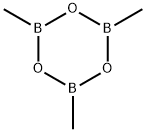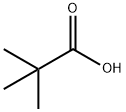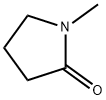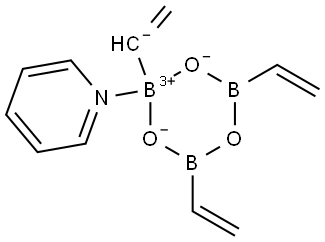Trimethylboroxine
- CAS NO.:823-96-1
- Empirical Formula: C3H9B3O3
- Molecular Weight: 125.53
- MDL number: MFCD00013354
- SAFETY DATA SHEET (SDS)
- Update Date: 2025-09-25 17:15:13

What is Trimethylboroxine?
Chemical properties
colorless to yellow solution
The Uses of Trimethylboroxine
Trimethylboroxine is used as a derivatizing agent for GLC analysis. It is used in a diverse array of areas, including as a polymerization additive. It is also used in the preparation of CBS catalysts for asymmetric reductions.
The Uses of Trimethylboroxine
Trimethylboroxine (TMB) is a cyclic anhydride of methyl-boronic acid. It can be used as a:
- Methylating agent for the methylation of various aromatic halides and C(sp3)?H bonds using palladium catalyst.
- Reagent in the preparation of polymer supported CBS (Corey, Bakshi, and Shibata) catalysts.
The Uses of Trimethylboroxine
Trimethylboroxine (TMB) is a cyclic anhydride of methyl-boronic acid. It can be been used:
- As a derivatizing agent for gas chromatographic/mass spectrometric analysis.
- In the preparation of methylaluminoxane (MAO) which is used in the polymerization of olefins.
- As an electrolyte additive to enhance the interface stability of electrode/electrolyte.
- In methylation of aryl halides by palladium-catalyzed Suzuki-Miyaura coupling reaction.
- In the preparation of CBS (Corey, Bakshi and Shibata) catalysts for asymmetric reductions of ketones to alcohols.
What are the applications of Application
Trimethylboroxine (TMB) is a cyclic anhydride of methyl-boronic acid. It can be been used:
As a derivatizing agent for gas chromatographic/mass spectrometric analysis.
In the preparation of methylaluminoxane (MAO) which is used in the polymerization of olefins.
As an electrolyte additive to enhance the interface stability of electrode/electrolyte.
In methylation of aryl halides by palladium-catalyzed Suzuki-Miyaura coupling reaction.
In the preparation of CBS (Corey, Bakshi and Shibata) catalysts for asymmetric reductions of ketones to alcohols.
Purification Methods
Possible impurity is methylboronic acid. If present, then add a few drops of conc H2SO4 and distil it immediately, then fractionate it through an efficient column. [McCusker et al. J Am Chem Soc 79 5179 1957, IR: Goubeau & Keller Z Anorg Allgem Chem 272 303 1953, Beilstein 4 IV 4378.]
Properties of Trimethylboroxine
| Melting point: | −38 °C(lit.) |
| Boiling point: | 78-80 °C(lit.) |
| Density | 0.898 g/mL at 25 °C(lit.) |
| refractive index | n |
| Flash point: | 16 °F |
| storage temp. | Flammables area |
| solubility | Chloroform (Sparingly), Dichloromethane (Slightly), THF (Soluble) |
| form | Solution |
| color | Colorless to yellow |
| Water Solubility | Not miscible in water. |
| Sensitive | Moisture Sensitive & Hygroscopic |
| BRN | 1757008 |
| Exposure limits | ACGIH: TWA 50 ppm; STEL 100 ppm (Skin) OSHA: TWA 200 ppm(590 mg/m3) NIOSH: IDLH 2000 ppm; TWA 200 ppm(590 mg/m3); STEL 250 ppm(735 mg/m3) |
| CAS DataBase Reference | 823-96-1(CAS DataBase Reference) |
Safety information for Trimethylboroxine
| Signal word | Danger |
| Pictogram(s) |
 Flame Flammables GHS02  Corrosion Corrosives GHS05  Exclamation Mark Irritant GHS07  Health Hazard GHS08 |
| GHS Hazard Statements |
H225:Flammable liquids H314:Skin corrosion/irritation H335:Specific target organ toxicity, single exposure;Respiratory tract irritation H351:Carcinogenicity |
| Precautionary Statement Codes |
P201:Obtain special instructions before use. P210:Keep away from heat/sparks/open flames/hot surfaces. — No smoking. P233:Keep container tightly closed. P261:Avoid breathing dust/fume/gas/mist/vapours/spray. P280:Wear protective gloves/protective clothing/eye protection/face protection. P370+P378:In case of fire: Use … for extinction. |
Computed Descriptors for Trimethylboroxine
| InChIKey | GBBSAMQTQCPOBF-UHFFFAOYSA-N |
Trimethylboroxine manufacturer
JSK Chemicals
New Products
4,4-Difluoropiperidine hydrochloride tert-butyl 9-methoxy-3-azaspiro[5.5]undecane-3-carboxylate Indole Methyl Resin N-Isopropylurea N,N-Dicyclohexylcarbodiimide(DCC) MELDRUMS ACID 5-METHYLISOXAZOLE-4-CARBOXYLIC ACID Magnessium Bis glycinate Zinc ascorbate 1-bromo-2-butyne 2-acetamidophenol 9(10H)-anthracenone Erythrosin B, 4-Piperidinopiperidine 2-((4-morpholinophenylamino) (methylthio) methylene) malononitrile 2,4-dihydroxybenzaldehyde 3-(4-morpholinophenylamino)-5-amino-1H-pyrazole-4-carbonitrile Methyl 2-methylquinoline-6-carboxylate 2,6-dichloro-4-nitropyridine 4-Bromo-2-chlorobenzonitrile 2-(benzylamino)acetic acid hydrochloride 4-(tert-Butoxycarbonylamino)but- 2-ynoic acid 3,4-dihydro-2H-benzo[b][1,4]dioxepine 1-Phenyl-1-cycloprppanecarboxylicacidRelated products of tetrahydrofuran








You may like
-
 823-96-1 Trimethylboroxine, 50% w/w soln. in TH 99%View Details
823-96-1 Trimethylboroxine, 50% w/w soln. in TH 99%View Details
823-96-1 -
 Trimethylboroxine (ca. 50% in Tetrahydrofuran) CAS 823-96-1View Details
Trimethylboroxine (ca. 50% in Tetrahydrofuran) CAS 823-96-1View Details
823-96-1 -
 Trimethylboroxine 50% w/w soln. in THF 95% CAS 823-96-1View Details
Trimethylboroxine 50% w/w soln. in THF 95% CAS 823-96-1View Details
823-96-1 -
 Trimethylboroxine CAS 823-96-1View Details
Trimethylboroxine CAS 823-96-1View Details
823-96-1 -
 Trimethylboroxine CAS 823-96-1View Details
Trimethylboroxine CAS 823-96-1View Details
823-96-1 -
 20677-73-0 (2,2-diethoxyethyl)methylamine 98%View Details
20677-73-0 (2,2-diethoxyethyl)methylamine 98%View Details
20677-73-0 -
 3-(4-(hydroxyamino)-1-oxoisoindolin-2-yl)piperidine-2,6-dione 98%View Details
3-(4-(hydroxyamino)-1-oxoisoindolin-2-yl)piperidine-2,6-dione 98%View Details -
 57381-49-4 2-bromo-4-chlorobenzonitrile 98%View Details
57381-49-4 2-bromo-4-chlorobenzonitrile 98%View Details
57381-49-4
